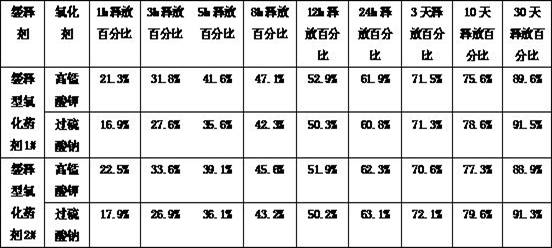Slow-release oxidizing agent for removing underground water polluted organic matters, and process thereof
A groundwater pollution and oxidizing agent technology, which is applied in the direction of contaminated groundwater/leachate treatment, water/sewage treatment, oxidized water/sewage treatment, etc., can solve the problem of reducing the utilization efficiency of oxidants, difficult to control the dispersion of oxidants, short half-life of oxidants, etc. problems, achieve the effect of reducing irrelevant consumption, improving repair effect, and improving oxidation efficiency
- Summary
- Abstract
- Description
- Claims
- Application Information
AI Technical Summary
Problems solved by technology
Method used
Image
Examples
Embodiment 1
[0024] Example 1 Slow-release oxidizing agent for removing groundwater polluting organic matter
[0025] 1.1 Weigh 3 g of polybutylene succinate and dissolve it in 6 mL of deionized water to obtain a sustained-release matrix solution;
[0026] 1.2 Weigh 60g of polyacrylamide, 10g of sodium hydroxymethylcellulose, 1.2g of polyvinylpyrrolidone, 1.5g of cyclodextrin and 8g of stearic acid, heat and dissolve in 300mL of deionized water to obtain a slow-release solution;
[0027] 1.3 Weigh 12 g of montmorillonite, sieve it with a 160-mesh standard sieve after crushing, to obtain montmorillonite powder;
[0028] 1.4 Weigh 5g of sodium persulfate and 15g of potassium permanganate, and dissolve them in 80g of deionized water to obtain an oxidation solution;
[0029] 1.5 Add the montmorillonite powder obtained in step 1.3 to the oxidation solution obtained in step 1.4, and mix well to obtain an adsorption oxidation solution;
[0030] 1.6 Add the adsorption oxidation solution obtained...
Embodiment 3
[0040] Example 3 Application of Slow-release Oxidant for Removing Groundwater Polluted Organic Matter
[0041] 3.1 Dissolve the slow-release oxidant 1# obtained in Example 1 and the slow-release oxidant 2# obtained in Example 2 in water to test the dissolution of the oxidants sodium persulfate and potassium permanganate, respectively at 1h and 3h , 5h, 8h, 12h, 24h, 3 days, 10 days, 30 days sampling test, the results are as follows:
[0042]
[0043] Experimental area Oxidation percentage of TCE on day 1 Oxidation percentage of TCE on day 3 Oxidation percentage of TCE on day 10 Oxidation percentage of TCE on day 20 Experimental area A 75.9% 85.6% 92.6% 95.1% Experimental area B 76.3 81.3% 93.2% 97.2% Experimental area C 65.8% 66.3% 65.9% 67.1% Experimental area D 1.1% 0.63% 0.52% 0.83%
[0044] As can be seen from the above examples, the present invention has a relatively high slow-release effect, and can effectively ...
PUM
 Login to View More
Login to View More Abstract
Description
Claims
Application Information
 Login to View More
Login to View More - R&D
- Intellectual Property
- Life Sciences
- Materials
- Tech Scout
- Unparalleled Data Quality
- Higher Quality Content
- 60% Fewer Hallucinations
Browse by: Latest US Patents, China's latest patents, Technical Efficacy Thesaurus, Application Domain, Technology Topic, Popular Technical Reports.
© 2025 PatSnap. All rights reserved.Legal|Privacy policy|Modern Slavery Act Transparency Statement|Sitemap|About US| Contact US: help@patsnap.com

